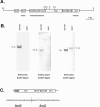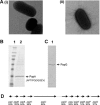Molecular characterization of the Escherichia coli asymptomatic bacteriuria strain 83972: the taming of a pathogen
- PMID: 16369040
- PMCID: PMC1346676
- DOI: 10.1128/IAI.74.1.781-785.2006
Molecular characterization of the Escherichia coli asymptomatic bacteriuria strain 83972: the taming of a pathogen
Abstract
Escherichia coli 83972 is a clinical asymptomatia bacteriuric isolate that is able to colonize the human urinary bladder without inducing an immune response. Here we demonstrate that one of the mechanisms by which this strain has become attenuated is through the mutation of its genes encoding type 1 and P fimbriae.
Figures




Similar articles
-
Virulence properties of Escherichia coli 83972, a prototype strain associated with asymptomatic bacteriuria.Infect Immun. 1999 Jan;67(1):429-32. doi: 10.1128/IAI.67.1.429-432.1999. Infect Immun. 1999. PMID: 9864249 Free PMC article.
-
P fimbriae enhance the early establishment of Escherichia coli in the human urinary tract.Mol Microbiol. 2000 Nov;38(3):456-64. doi: 10.1046/j.1365-2958.2000.02165.x. Mol Microbiol. 2000. PMID: 11069670
-
Asymptomatic bacteriuria Escherichia coli strain 83972 carries mutations in the foc locus and is unable to express F1C fimbriae.Microbiology (Reading). 2006 Jun;152(Pt 6):1799-1806. doi: 10.1099/mic.0.28711-0. Microbiology (Reading). 2006. PMID: 16735742
-
Mellowing out: adaptation to commensalism by Escherichia coli asymptomatic bacteriuria strain 83972.Infect Immun. 2007 Aug;75(8):3688-95. doi: 10.1128/IAI.01730-06. Epub 2007 May 14. Infect Immun. 2007. PMID: 17502385 Free PMC article. Review. No abstract available.
-
Bacterial pili: molecular mechanisms of pathogenesis.Curr Opin Microbiol. 2000 Feb;3(1):65-72. doi: 10.1016/s1369-5274(99)00053-3. Curr Opin Microbiol. 2000. PMID: 10679419 Review.
Cited by
-
Reciprocal Packaging of the Main Structural Proteins of Type 1 Fimbriae and Flagella in the Outer Membrane Vesicles of "Wild Type" Escherichia coli Strains.Front Microbiol. 2021 Feb 12;12:557455. doi: 10.3389/fmicb.2021.557455. eCollection 2021. Front Microbiol. 2021. PMID: 33643229 Free PMC article.
-
Urinary tract infection in women: new pathogenic considerations.Curr Infect Dis Rep. 2006 Nov;8(6):465-72. doi: 10.1007/s11908-006-0021-9. Curr Infect Dis Rep. 2006. PMID: 17064640
-
Asymptomatic bacteriuria: when the treatment is worse than the disease.Nat Rev Urol. 2011 Dec 6;9(2):85-93. doi: 10.1038/nrurol.2011.192. Nat Rev Urol. 2011. PMID: 22143416 Review.
-
Molecular analysis of asymptomatic bacteriuria Escherichia coli strain VR50 reveals adaptation to the urinary tract by gene acquisition.Infect Immun. 2015 May;83(5):1749-64. doi: 10.1128/IAI.02810-14. Epub 2015 Feb 9. Infect Immun. 2015. PMID: 25667270 Free PMC article.
-
Metabolomics Study on Pathogenic and Non-pathogenic E. coli with Closely Related Genomes with a Focus on Yersiniabactin and Its Known and Novel Derivatives.Metabolites. 2020 May 28;10(6):221. doi: 10.3390/metabo10060221. Metabolites. 2020. PMID: 32481767 Free PMC article.
References
-
- Bergsten, G., M. Samuelsson, B. Wullt, I. Leijonhufvud, H. Fischer, and C. Svanborg. 2004. PapG-dependent adherence breaks mucosal inertia and triggers the innate host response. J. Infect. Dis. 189:1734-1742. - PubMed
-
- Bock, K., M. E. Breimer, A. Brignole, G. C. Hansson, K. A. Karlsson, G. Larson, H. Leffler, B. E. Samuelsson, N. Stromberg, C. S. Eden, et al. 1985. Specificity of binding of a strain of uropathogenic Escherichia coli to Gal alpha 1→4Gal-containing glycosphingolipids. J. Biol. Chem. 260:8545-8551. - PubMed
-
- Dodson, K. W., J. S. Pinkner, T. Rose, G. Magnusson, S. J. Hultgren, and G. Waksman. 2001. Structural basis of the interaction of the pyelonephritic E. coli adhesin to its human kidney receptor. Cell 105:733-743. - PubMed
Publication types
MeSH terms
LinkOut - more resources
Full Text Sources
Medical

